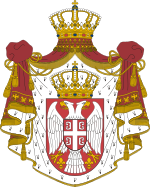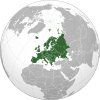塞爾維亞經濟
 贝尔格莱德是塞尔维亚的金融中心 | |
| 货币 | 塞尔维亚第纳尔 |
|---|---|
| 财政年度 | 历年 |
贸易组织 | 中欧自由贸易协定、黑海经济合作组织和迷你申根区 |
| 统计数据 | |
| 人口 | ▼ 6,926,705(2020年1月1日)[1] |
| GDP | $1408.78亿 |
GDP增长率 |
|
人均GDP | |
各产业GDP |
|
| 1.2%(2020年预计)[3] | |
| ▼ 33.3 中等(2019年)[7] | |
劳动力 | |
各产业劳动力 |
|
| 失业率 | |
主要产业 | 机动车、卑金属、食品加工、机械、化学品、轮胎和药品 |
| ▲第44名,非常容易[15] | |
| 对外贸易 | |
| 出口 | ▲ $255亿(2019年)[16] |
出口商品 | 汽车(24.2亿美元)、电机(20.33亿美元)、有色金属(20.05亿美元)、橡胶和塑料制品(16.7亿美元)、化工和化工产品(11.93亿美元) |
主要出口伙伴 | |
| 进口 | ▲ $258亿(2018年)[16] |
进口商品 | 化学品和化学产品(24.04亿美元)、通用机械(2.1亿美元)、石油和天然气(19.7.7亿美元)、汽车(18.18亿美元)和基本金属(17.4亿美元) |
主要进口伙伴 | |
| ▼ −$23.54亿(2017年估计)[18] | |
外债总额 | ▼ $245亿(2019年估计) |
| 公共财政 | |
| ▲ GDP的56.3%[19] | |
| 收入 | 176.9亿(2017年估计)[18][note 1] |
| 支出 | 175.9亿(2017年估计)[18] |
| 塞尔维亚经济 |
|---|
 |
| 概览 |
| 类型 |
| 主题 |
塞爾維亞經濟在2000年以後穩步發展。但在1992年到1995年期间,以塞爾維亞為主的南斯拉夫聯盟共和國曾經遭遇联合国制裁。在1999年北约的空袭中,塞尔维亚的許多交通及電力等基础设施遭遇严重破壞。这些因素导致在1990年代,塞尔维亚经济出现大幅倒退。目前塞尔维亚经济存在的主要问题包括非常高的失业率(2005年时达20%)和悬而未决的科索沃问题。
塞爾維亞在南斯拉夫時期是僅次於斯洛文尼亞和克羅地亞的地區,該國最大的城市貝爾格萊德在南斯拉夫時期已是首都。南斯拉夫在1990年代初分裂並爆發內戰,由米洛舍维奇領導的南斯拉夫聯邦遭受西方國家抵制,美國為首的北約組織更於1999年為支持科索沃獨立,大規模空襲南斯拉夫聯邦。在2000年10月米洛舍维奇下台后,塞爾維亞與歐盟成員國的關係改善,塞尔维亚经济出现了较快的增长(2006年经济成长率达到6.3%)。因其经济的快速成长,塞尔维亚被一些人称为“巴尔干之虎”。
數據[编辑]
- 國民生產總值
- US$77,800,000,000
- 產業比例
- 農業:12.3%
- 製造業:24.2%
- 服務業:63.5%
| GDP | |||||||||||||||||
|---|---|---|---|---|---|---|---|---|---|---|---|---|---|---|---|---|---|
| 年份 | 2000 | 2001 | 2002 | 2003 | 2004 | 2005 | 2006 | 2007 | 2008 | 2009 | 2010 | 2011 | 2012 | 2013 | |||
| GDP (USD Billions) | 8.7 | 11.4 | 15.1 | 19.5 | 23.7 | 25.2 | 29.3 | 39.0 | 47.7 | 40.1 | 38.0 | 46.4 | 48.5 | 52.5 | |||
| GDP growth rate | 5.3% | 5.6% | 3.9% | 2.4% | 9.3% | 5.4% | 5.2% | 6.9% | 5.5% | -3.0% | 1.8% | 1.9% | 1.1% | 4.0% | |||
| GDP Per Capita (USD) | 1152 | 1524 | 2012 | 2613 | 3169 | 3391 | 3958 | 5277 | 6467 | 5438 | 5139 | 6267 | 6539 | 7058 | |||
| GDP (PPP) per capita (Geary-Khamis $) | 5655 | 6100 | 6468 | 6786 | 7598 | 8315 | 8928 | 9722 | 10316 | 10060 | 10252 | 10661 | 12121 | 13122 | |||
| Source: IMF [23] | |||||||||||||||||
參考[编辑]
- ^ Population on 1 January. www.stat.gov.rs/en-us/. Statistical Office of the Republic of Serbia. [1 July 2020]. (原始内容存档于2020-12-22).
- ^ Stattistical Office of Republic of Serbia. Economic trends in the Republic of Serbia in 2020 (estimates). stat.gov.rs. 2020-12-30 [2021-01-01]. (原始内容存档于2020-12-30).
- ^ 3.0 3.1 3.2 World Economic Outlook Database, October 2020. IMF.org. International Monetary Fund. [13 October 2020]. (原始内容存档于2020-10-21).
- ^ GROSS DOMESTIC PRODUCT (GDP) 2015 – 2017 (PDF). Statistical Office of the Republic of Serbia. [2021-02-07]. (原始内容存档 (PDF)于2020-03-13).
- ^ N1. Više od sedam odsto građana imalo potrošnju ispod linije apsolutnog siromaštva. N1 Srbija. 17 October 2019 [21 June 2019]. (原始内容存档于2020-02-23).
- ^ People at risk of poverty or social exclusion. ec.europa.eu/eurostat. Eurostat. [25 October 2020]. (原始内容存档于2020-11-11).
- ^ Gini coefficient of equivalised disposable income - EU-SILC survey. ec.europa.eu. Eurostat. [25 October 2020]. (原始内容存档于2020-04-08).
- ^ Human Development Index (HDI) (PDF). hdr.undp.org. HDRO (Human Development Report Office) United Nations Development Programme. [16 December 2020]. (原始内容存档 (PDF)于2020-12-15).
- ^ Inequality-adjusted HDI (IHDI) (PDF). hdr.undp.org. UNDP. [16 December 2020]. (原始内容存档 (PDF)于2020-12-15).
- ^ Labor force, total - Serbia. data.worldbank.org. World Bank & ILO. [28 November 2019]. (原始内容存档于2019-11-28).
- ^ 11.0 11.1 Labour Force Survey, II quarter 2020. www.stat.gov.rs. Statistical Office of the Republic of Serbia. [31 August 2020]. (原始内容存档于2021-02-07).
- ^ Labor Force Survey (PDF). Statistical Office of the Republic of Serbia. 2018 [2019-07-26]. (原始内容存档 (PDF)于2019-08-08).
- ^ Ekonomska kretanja 2020. www.stat.gov.rs. Statistical Office of the Republic of Serbia. [30 December 2020]. (原始内容存档于2021-01-23).
- ^ Youth unemployment rate by sex, age (15-24). Statistical Office of the Republic of Serbia. [12 May 2020]. (原始内容存档于2021-02-28).
- ^ Rankings. World Bank. [21 June 2019]. (原始内容存档于2018-09-15).
- ^ 16.0 16.1 FINAL DATA, 2018 (PDF). Statistical Office of the Republic of Serbia. [2021-02-07]. (原始内容存档 (PDF)于2019-08-08).
- ^ 17.0 17.1 РЕПУБЛИКЕ СРБИЈЕ (PDF). Република Србија Републички завод за статистику. [2021-02-07]. (原始内容存档 (PDF)于2020-11-24).
- ^ 18.0 18.1 18.2 The World Factbook. CIA.gov. Central Intelligence Agency. [18 August 2019]. (原始内容存档于2021-02-04).
- ^ Europe and Central Asia Economic Update, Spring 2020 : Fighting COVID-19. 世界银行. [2021-02-07]. (原始内容存档于2020-12-28).
- ^ 20.0 20.1 20.2 20.3 20.4 Republic of Serbia's long-term credit rating. www.nbs.rs. [21 June 2019]. (原始内容存档于2019-04-05).
- ^ Fitch — Complete Sovereign Rating History. [4 August 2014]. (原始内容存档于2017-08-06).
- ^ Fitch Revises Serbia's Outlook to Positive; Affirms at 'B+'. 18 December 2015 [21 June 2019]. (原始内容存档于2019-04-16) –通过www.reuters.com.
- ^ [1] (页面存档备份,存于互联网档案馆) IMF
- ^ 数据包括中央和地方政府预算
| ||||||||||||||||||||||||||||||||||||||||||||||||||||||||||||||||||||||||||||||||||||||||
| ||||||||||||||||||||||||


